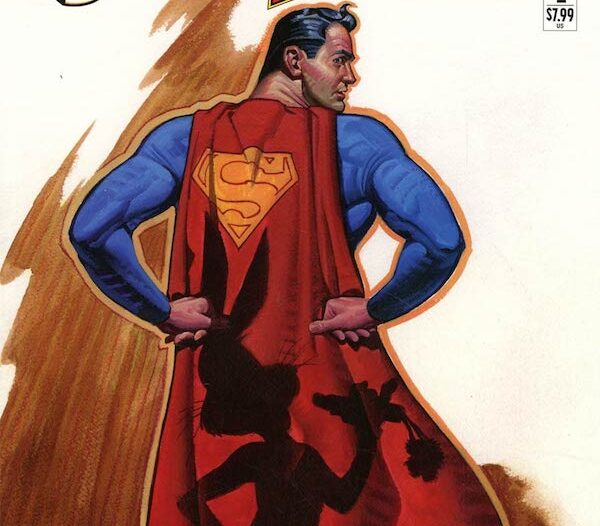
Review: ‘DC/Looney Tunes 100-Page Super Spectacular’ #1
DC/Looney Tunes 100-Page Super Spectacular #1
Writer: Mark Evanier
Artists: Joe Staton, Tom Palmer, and Mike DeCarlo
DC Comics; $7.99
Rated E for Everyone
DC Comics rather recently published a round of strange team-ups between some of their superhero properties and altered versions of Hanna-Barbra cartoon characters, an experiment apparently inspired by their Hanna-Barbera reboot comics for adults. It must have proved a success for them, as this month they will be publishing a half-dozen strange team-ups between some of their superhero properties and altered versions of Looney Tunes cartoon characters: Batman/Elmer Fudd, Lobo/Road Runner, The Legion of Super-Heroes/Bugs Bunny and so on.
While those will all be directed at the publisher’s regular teenage and adult reading audience (and thus rated “T for Teen”), one happy result is that it returned to print a rather bizarre, semi-forgotten crossover miniseries from back in 2000: Superman & Bugs Bunny, re-titled on the spine and in the fine print as DC/Looney Tunes to better reflect the characters involved (But, oddly, still bearing the original title on the new painted cover by Steve Rude).
ADVERTISEMENT
ADVERTISEMENT
Unlike the teenage audience of the upcoming DC/Looney Tunes crossovers, this one is all-ages and completely kid-friendly, and the Looney Tunes characters are completely unaltered from their appearances in their cartoons…and/or DC’s Looney Tunes comic.
Writer Mark Evanier, a veteran of both TV cartoon writing and comics writing, takes the most direct route possible to mixing up the two groups of characters: Superman’s fifth-dimensional imp foe, Mr. Mxyzptlk. Practically a Looney Tune character himself, Mxy is having his regular match of wits with Superman and finds himself frustrated to once again be tricked into temporary exile.
Meanwhile, Bugs Bunny and Elmer Fudd are having their typical interactions when they are interrupted by The Do-Do, a fairly obscure character from the great 1938 short, “Porky Pig in Wackyland,” its color remake and…that’s about it, really (Reflecting his age, The Do-Do appears throughout colored in the grays of that original black-and-white cartoon.)
Both The Do-Do and Mxy are looking for new stomping grounds in which to cause mischief when they cross paths. After Mxy tries to make himself at home in the Looney Tunes universe, where he’s simply out-cartooned by the likes of Daffy Duck and Foghorn Leghorn, he comes up with a particularly devious Plan B: Shunting the Looney Tunes characters all over into the DC Universe.
Most of the series is devoted to the chaos this causes, with Mxy occasionally upping the ante by doing things like stripping Superman’s powers and awarding them to Elmer Fudd, “The Wast Son of Kwypton,” or convincing Daffy Duck that he’s really that fearsome creature of the night, “The Duck Knight Detec-a-tive.” Because this is the DC Universe, in addition to the culture clash, Superman’s peers in the Justice League also have a supervillain to deal with, The Toyman.
ADVERTISEMENT
ADVERTISEMENT
Evanier hits most of the expected notes, like having The Flash get left in the dust by first Speedy Gonzales and than The Road Runner, but there are some surprisingly deep cuts too, with one through-line being Green Arrow re-enacting the part of the protagonist from “One Froggy Evening,” wherein he has a frog in a box that sings and dances with a top hat and cane—that’s Michigan J. Frog, to Looney Tunes fans—but only when GA is looking. Whenever he tries to show the singing frog to someone, it just sits there like a normal frog, croaking.
Evanier’s paired with equally veteran artists, with Joe Staton providing layouts and Tom Palmer and Mike DeCarlo finishing the art. They do a pretty remarkable job of drawing the DC Universe and its denizens in the style readers would have been accustomed to seeing them, and the Looney Tunes characters in the style readers would have been accustomed to seeing them, so the juxtaposition is as jarring for the reader as it would be for the characters. Sure, everyone may be drawn in pencil and ink here, but the cartoon characters look like cartoon characters and stand out as such next to the “real” characters of the DC Universe, what with all their detail and shading and what not.
Because this comic is an artifact of 2000, Evanier and company were working the the JLA line-up of the time, meaning some of the DC characters might look weird to modern young readers, as that was when Kyle Rayner and Connor Hawke were Green Lantern and Green Arrow respectively, and Aquaman was long-haired, bearded, and had a harpoon instead of his left-hand. As prevalent as various versions of all DC’s superheroes are in cartoons these days, though, it shouldn’t exactly prove a barrier. While, say, Plastic Man and Martian Manhunter rarely appear in current DC Comics, they are regular presences in the direct-to-DVD Lego movies and appear in Batman: The Brave and The Bold and Justice League Unlimted and so on.
And it’s not like the ins-and-outs of the superheroes’ specific backstories come into play or anything. One need not know what happened to Aquaman’s hand or why he looks like a blonde Jason Momoa to scan the weird visual gags involved in a scene of him faced with Yosemite Sam firing a cartoon cannon at him from the bow of a pirate ship.
About J. Caleb Mozzocco
J. Caleb Mozzocco is a way-too-busy freelance writer who has written about comics for online and print venues for a rather long time now. He currently contributes to Comic Book Resources' Robot 6 blog and ComicsAlliance, and maintains his own daily-ish blog at EveryDayIsLikeWednesday.blogspot.com. He lives in northeast Ohio, where he works as a circulation clerk at a public library by day.
ADVERTISEMENT
ADVERTISEMENT
SLJ Blog Network
2024 Books from Coretta Scott King Winners
The Ultimate Love Letter to the King of Fruits: We’re Talking Mango Memories with Sita Singh
Parsing Religion in Public Schools
ADVERTISEMENT








